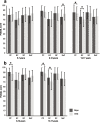Sex differences in children's health status as measured by the Pediatric Quality of Life Inventory (PedsQL)™: cross-sectional findings from a large school-based sample in the Netherlands
- PMID: 34922476
- PMCID: PMC8683815
- DOI: 10.1186/s12887-021-03059-3
Sex differences in children's health status as measured by the Pediatric Quality of Life Inventory (PedsQL)™: cross-sectional findings from a large school-based sample in the Netherlands
Abstract
Background: Previous research has shown that female adolescents and adults report lower health status than their male peers. Possibly, this discrepancy already develops during childhood. We collected sex-specific data with the Pediatric Quality of Life Inventory (PedsQL) in a large school-based sample.
Methods: The online version of the PedsQL was administered to healthy Dutch children aged 5-7 years (parent proxy-report), 8-12 years (parent proxy-report and child self-report), and 13-17 years (parent proxy-report and child self-report), recruited through regular primary and secondary schools. Sex differences were assessed using t-tests or Mann-Whitney U-tests. Wilcoxon signed-rank tests and intraclass correlation coefficients served to compare parent proxy-reports with child self-reports. Multivariable linear regression analyses were used to assess the associations of sex of the child, age, and parental educational level with PedsQL scores.
Results: Eight hundred eighty-two parents and five hundred eighty one children were recruited from 15 different schools in the Netherlands. Parents of 8-to-12-year-olds reported higher scores on School Functioning for girls than for boys (mean difference [MD]: 6.56, p < 0.001). Parents of 13-to-17-year-olds reported lower scores on Physical and Emotional Functioning for girls than for boys (MDs: 2.14 and 5.79, p = 0.014 and p < 0.001, respectively). Girls aged 8-12 years reported lower scores than boys in this age group on Physical Functioning (MD: 3.09, p = 0.005). Girls aged 13-17 years reported lower scores than boys in this age group on Physical Functioning (MD: 3.67, p < 0.001), Emotional Functioning (MD: 8.11, p < 0.001), and the Total Score (MD 3.26, p = 0.004). No sex differences were found in children aged 5-7 years. Agreement between child self-reports and parent proxy-reports was poor to moderate.
Conclusions: Girls generally had lower PedsQL scores than boys, both in parent proxy-reports and in child self-reports. We recommend to apply sex-specific data when assessing health status using the PedsQL.
Keywords: Children; Health status; Health-related quality of life; PedsQL; Sex differences.
© 2021. The Author(s).
Conflict of interest statement
The authors declare that they have no competing interests.
Figures


Similar articles
-
Factors influencing agreement between child self-report and parent proxy-reports on the Pediatric Quality of Life Inventory 4.0 (PedsQL) generic core scales.Health Qual Life Outcomes. 2006 Aug 30;4:58. doi: 10.1186/1477-7525-4-58. Health Qual Life Outcomes. 2006. PMID: 16942613 Free PMC article.
-
Health-related quality of life in paediatric arterial hypertension: a cross-sectional study.BMC Pediatr. 2018 May 1;18(1):146. doi: 10.1186/s12887-018-1120-0. BMC Pediatr. 2018. PMID: 29716573 Free PMC article.
-
Adolescent self-report and parent proxy-report of health-related quality of life: an analysis of validity and reliability of PedsQL 4.0 among a sample of Malaysian adolescents and their parents.Health Qual Life Outcomes. 2015 Apr 8;13:44. doi: 10.1186/s12955-015-0234-4. Health Qual Life Outcomes. 2015. PMID: 25889663 Free PMC article.
-
Do parents and children agree on rating a child's HRQOL? A systematic review and Meta-analysis of comparisons between children with attention deficit hyperactivity disorder and children with typical development using the PedsQLTM.Disabil Rehabil. 2019 Feb;41(3):265-275. doi: 10.1080/09638288.2017.1391338. Epub 2017 Oct 23. Disabil Rehabil. 2019. PMID: 29057670
-
Quality of life of children and young adults with Down syndrome from caregivers' perspective: A systematic review and meta-analysis.Ann Acad Med Singap. 2024 Aug 14;53(8):502-513. doi: 10.47102/annals-acadmedsg.2023415. Ann Acad Med Singap. 2024. PMID: 39230318
Cited by
-
Feasibility, acceptability and preliminary effectiveness of a mental health drop-in centre for the siblings of young people attending a paediatric hospital.J Child Health Care. 2025 Jun;29(2):381-396. doi: 10.1177/13674935231206895. Epub 2023 Oct 18. J Child Health Care. 2025. PMID: 37850534 Free PMC article.
-
Effectiveness of Generic and Disease-Specific Questionnaires in Assessing Quality of Life in Children With Type 1 Diabetes.Cureus. 2025 May 11;17(5):e83931. doi: 10.7759/cureus.83931. eCollection 2025 May. Cureus. 2025. PMID: 40502897 Free PMC article.
-
The Reliability of the Thai version of Health-Related Quality of Life Questionnaire: PedsQL 3.0 Cancer Module.Glob Pediatr Health. 2022 Apr 30;9:2333794X221092738. doi: 10.1177/2333794X221092738. eCollection 2022. Glob Pediatr Health. 2022. PMID: 35521436 Free PMC article.
-
Quality of life in children with erythropoietic protoporphyria: a case-control study.J Dermatol. 2024 Aug;51(8):1068-1078. doi: 10.1111/1346-8138.17348. Epub 2024 Jun 26. J Dermatol. 2024. PMID: 38923596 Free PMC article.
-
Associations among COVID-19 Family Stress, Family Functioning, and Child Health-Related Quality of Life through Lifestyle Behaviors in Children.Children (Basel). 2024 Apr 18;11(4):483. doi: 10.3390/children11040483. Children (Basel). 2024. PMID: 38671700 Free PMC article.
References
MeSH terms
LinkOut - more resources
Full Text Sources
Medical
Research Materials
Miscellaneous

